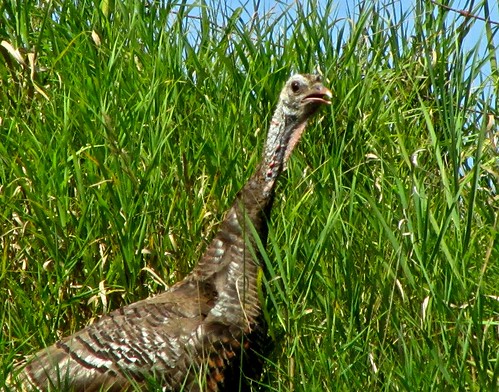Grassfed Ranchers and the Lean Meat Drug
By Stanley A. Fishman, author of Tender Grassfed Meat and Tender Grassfed Barbecue
Have you ever heard of ractopamine?
No? Do not feel bad, almost no one outside the meat and drug industry has heard of this drug. Yet, chances are that you have ingested residues of ractopamine a number of times, if you eat conventional pork, beef, or turkey.
Not to worry. Meat with the levels of residue allowed by the FDA is safe for human consumption. Our government says it is safe, so it is safe. Disturbingly, the European Union and even China disagrees, banning the import of American meat that contains residues of ractopamine, even at the safe levels set by the FDA.
But everyone agrees that ractopamine reduces the amount of fat in meat, making for leaner meat. It also enhances the growth of animals, making them bigger.
Since the fat of grassfed and pastured animals is the most nutrient-dense part, making the meat more tender and adding great flavor, I am completely opposed to any drug that would make meat leaner.
For this reason, I contacted my local farmer and every source I use for grassfed beef and pastured pork to see if they used ractopamine. The results will be discussed later in this post.
Saturated Fat Phobia Leads to the Development of Ractopamine
The insane fear of saturated animal fat led to the development of the lean, tasteless, tough pork that is so common today. As part of that process, ractopamine was developed. This drug does actually make the meat of animals leaner. Lean meat is what Big Ag wanted to sell, especially lean pork, which they used to call “the other white meat.â€
- Ractopamine was approved for pork in 1999.
- Ractopamine was approved for beef in 2003.
- Ractopamine was approved for turkey in 2008.
At this point, ractopamine is believed to be added to the feed of sixty to eighty percent of the pigs slaughtered for meat in the U.S.
Problems Arise
A problem arose soon after the introduction of ractopamine into the pork supply—the FDA received many reports of pigs becoming very ill, and even dying. The FDA dealt with this problem by asking the manufacturer to include a warning insert with the drug, which the manufacturer did.
A second problem arose when the European Union and China refused to allow meat with detectable ractopamine residues to be sold in their respective countries, even when the residue was at or below the level the FDA has declared safe. This issue is still in dispute, and has not been resolved. This has put a serious dent in American pork exports, and some beef exports. The solution seems simple enough—stop using ractopamine, and open up those markets. Yet Big Ag refuses to stop using the drug, and has persuaded the U.S. government to pressure the Europeans and Chinese into allowing the importation of U.S. meat with ractopamine residues. So far, the pressure has not worked.
Grassfed and Pastured Fat Is Nutritious and Makes Meat Delicious
Saturated animal fat is perhaps the most demonized of all foods. Yet this fat, if it comes from grassfed or pastured animals, is the very best source of many vital nutrients. The fat of grassfed and pastured animals is one of the oldest human foods, and nutrients from this fat are easily assimilated by the human body. See The Skinny on Fats.
I want my meat to have more fat, not less, and I certainly do not want to eat meat that has been made leaner by a drug, even if the meat is safe for human consumption.
The natural fat of grassfed and pastured animals helps keep the meat tender, and adds terrific natural flavor.
Anyone who has had the misfortune of eating the lean, tough, tasteless pork so common in the U.S. will understand why I never touch the stuff. It is tough and tastes terrible. But pastured pork, from heritage breeds, with plenty of fat, is absolutely delicious, and very tender.
I Poll My Grassfed Farmers
I asked my local farmer and all the producers I buy meat from, if they use ractopamine.
This includes Humboldt Grassfed Beef (my local farmer), U.S. Wellness Meats, Homestead Natural Foods, Alderspring Ranch, and Gaucho Ranch.
I am happy to say that NONE of them use any drug to raise their cattle or pigs, and that most of them had never even heard of ractopamine. These fine grassfed ranchers and farmers raise their meat the natural way, on grass, using their skill at raising grassfed and pastured animals to produce wonderful, healthy meat. I am so grateful to all of them for making this good meat available to me and my family, and so many others.
My solution to the issue is the same solution I use for almost every meat issue—buy only grassfed and pastured meats, and buy them only from ranchers I know and trust.
Sure has resulted in a number of delicious meals that make me feel so good!
If you are interested in learning more about ractopamine and the issues involving it, here is a link to an excellent and comprehensive article on the subject. Dispute over drug in feed limiting US meat exports
This post is part of Real Food Wednesday blog carnival.
Turkey Broth from Leftovers — Paleo, Primal, and Delicious
By Stanley A. Fishman, author of Tender Grassfed Meat and Tender Grassfed Barbecue
One of the almost inevitable issues created by the Thanksgiving feast is what to do with the leftovers. One of the recipes in Tender Grassfed Meat is the best solution I have come up with. Not only does it solve the problem, it gives you a delicious, flavorful broth full of nutrients.
This is a traditional broth, using only real food. Even the salt is unrefined. In fact, this recipe works great for those on Paleo or Primal diets. The only exception would be those whose version of a Paleo or Primal diet excludes salt. I am convinced that the cave people ate salt. First, if you do not get enough salt, you die. They survived and thrived. Second, every hunter-gatherer group ever studied added salt to their food, at least some of the time. They got their salt from the same source the cave people probably did—salt licks. They found the salt licks the same way—by tracking animals, because they knew the animals would know where to find salt. Yes, even wild animals eat salt, and they know where to find it.
I have gotten very positive feedback on this recipe. If you do not have giblets, the soup will still be great. Here it is:
Turkey Broth
This broth is THE solution for leftover turkey, for all of it. The leftover turkey bones become a valued asset, contributing minerals, natural gelatin, and many nutrients. I always save the turkey drumsticks for this broth, as the drumstick’s meat and many tendons transform into a wonderful gelatin in the broth. You can also use turkey wings, which are often sold separately. Turkey wings are wonderful for broth due to their high natural gelatin content. Turkey broth, much like chicken broth, is delicious and nourishing.
You will need a large stockpot for this one. Make sure that it is stainless steel, not aluminum. The long cooking time is necessary to combine the flavors, and to get the nutrients out of the bones.
Makes 6 to 8 quarts
INGREDIENTS
Leftover bones and carcass from a roasted turkey, or 4 to 6 pounds turkey wings
Turkey neck, (if available)
Enough filtered water to cover the bones by 2 to 3 inches
½ cup raw organic apple cider vinegar
ASSORTED ROOT VEGETABLES
1 large organic onion, peeled and coarsely chopped
4 stalks of organic celery, coarsely chopped
4 large organic carrots, peeled and coarsely chopped
4 cloves of organic garlic, peeled and coarsely chopped
FOR SIMMERING
Several chicken giblets (if available)
Turkey giblets, (if available)
1 bunch of organic Italian parsley, each stalk cut into 2 or 3 pieces
2 tablespoons coarse unrefined sea salt
- Put the turkey into the pot, except for the giblets. Add the water and the vinegar. Let sit at room temperature for 1 hour.
- Add all the vegetables, except the parsley. Heat the pot until the water begins a strong simmer. This will take a while due to the large volume of ingredients and water.
- When the water is close to boiling, remove all the scum that rises to the top with a skimming spoon. This can also take a while, but is necessary.
- Once the scum is gone, add the giblets, parsley, and the salt.
- Cover and simmer gently for 12 to 14 hours.
Using a ladle, strain into jars, cover, and refrigerate once the bottles have cooled down. The fat will rise to the top, and will solidify in the refrigerator. This fat cap will help preserve the broth. The fat should be removed before the broth is reheated.
This recipe was inspired by the broth-making techniques demonstrated in Sally Fallon Morell’s wonderful book on traditional cooking, Nourishing Traditions.
Tender Grassfed Meat contains many traditional recipes for broth, as well as grassfed meat.
This post is part of Weekend Gourmet Blog Carnival, Monday Mania, Fat Tuesday and Real Food Wednesday blog carnivals.


 Photos of recipes from the new book Tender Grassfed Barbecue
Photos of recipes from the new book Tender Grassfed Barbecue
 Photos of recipes from the cookbook Tender Grassfed Meat
Photos of recipes from the cookbook Tender Grassfed Meat


